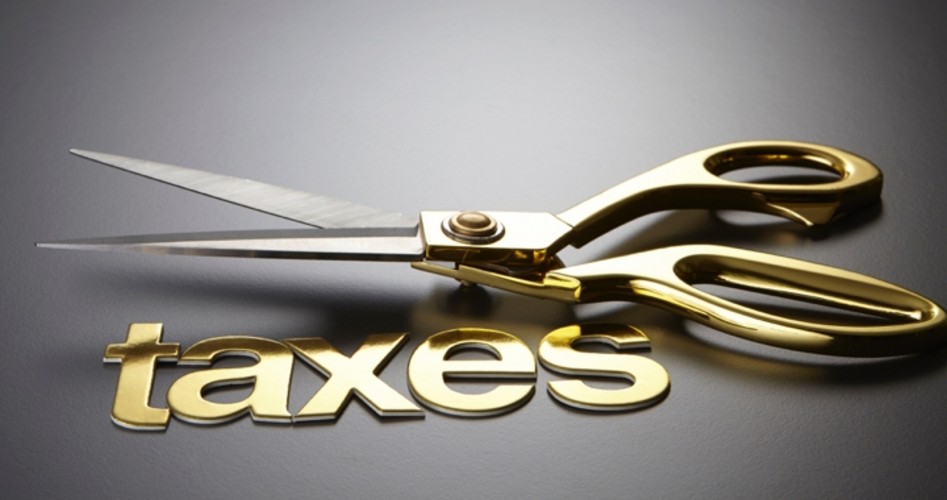American Principles
The ongoing debate over tax cuts has been framed, as it always is, in stark terms: Either we stimulate the economy by cutting taxes — leading to a rise in deficits and debts — or we raise taxes to pay the ever-higher cost of government. In general, Republicans have tended to favor the former, arguing that tax cuts, paradoxically, will lead to economic expansion and higher tax receipts over time. Democrats deny this, arguing that tax cuts will increase the debt and deficit, and leave America unable to defray the costs of government.
There is, however, an excluded option that neither side is willing to acknowledge: the possibility of cutting the size and cost of government. The debate over whether to raise or lower taxes is a false dilemma: It is the size of government, and not the level of taxation, that is the real rub.
The notion that tax cuts can lead to greater tax revenues has been popularized in recent decades by economist Arthur Laffer, whose “Laffer curve” suggests that somewhere between zero and 100 percent taxation rates (two extremes that are both assumed to yield zero revenue), there is an optimal rate that will lead to more revenue than either a lower or a higher rate. Economists disagree widely on what that rate may be, but the notion that there exists an optimal tax rate — which is significantly lower than current rates — is what is driving the GOP push for tax cuts right now.
But note well the underlying premise: Trump and the GOP want to cut taxes so that the government can maximize tax revenues. The entire notion of economic stimulus via tax cuts is motivated by the belief that it will actually lead to more revenues and facilitate more government spending.
That is precisely what happened back in the ’80s, when the Reagan administration, heavily influenced by Laffer and his acolytes, pushed for deep tax cuts. The economy did indeed take off, at least in part because of lower taxes (although they weren’t the only stimulus; monetary policies at the Federal Reserve under Chairman Paul Volcker and his successor, Alan Greenspan, also helped to fuel the long bull market of the ’80s and ’90s). And with the soaring economy, tax revenues soared as well.
But somehow, despite nearly two decades of unremitting economic growth, the government grew and grew. Deficits and debts exploded, prompting Reagan’s successor, President George H. W. Bush, to raise taxes. No sooner was he ousted from the White House for breaking his infamous “read my lips” promise not to raise taxes, than President Clinton raised taxes again.
The lesson to be extracted from the last three decades of taxing and spending is that while tax cuts do indeed stimulate the economy, they are no remedy for the larger problem, which is out-of-control government spending. Indeed, successful economic stimuli such as tax cuts tend to encourage higher levels of government spending, especially when the entire motive for such stimuli is to increase tax revenues. Nowhere in Washington does the notion that government itself needs to undergo drastic cuts have any traction.
Absent a moral commitment to cut government spending, the tax-and-spend cycle seems to run roughly as follows: The economy is in the doldrums, and public deficits and debts are sky-high, so taxes are cut to provide economic stimulus, causing the economy to grow, but also propelling government debt higher still. Once the economy is recovered, tax revenues have indeed risen, but not enough to make a dent in government debt. At this point, taxes are hiked to get debt under control, but eventually, higher tax rates discourage productivity and the economy goes back into the doldrums. New cries for tax cuts ensue, and the cycle starts anew.
At no point in this cycle is government spending cut. Indeed, even to persuade politicians to reduce the rate of spending increase is regarded these days in Washington as an affront to decency. If President Trump’s long-hoped-for tax cuts pass and produce more tax revenue in the long run, government spending will simply rise accordingly, since there is no consensus on the part of either major party on the need to meaningfully reduce government spending.
America seems to have entered a stage of widespread capitulation where debt and taxation are concerned. On Capitol Hill, there is no longer any political will even to craft annual budgets; instead, government is now financed by an endless series of temporary mammoth spending resolutions, with congressmen expected to vote for the entire spending package so as to avoid a government shutdown. Meanwhile, the general public has largely given up hope that our elected leadership will ever muster the political will to bring taxation and spending under control, no matter which party is in charge. President Trump’s calls for deep government cuts have been met with fury and derision in Congress and the media, and the president himself is now committed to the same course of “tax cuts now, tax hikes later” encouraged by the tax cut stimulus crowd. It is very possible that Trump and the GOP will finally score a long-sought legislative and political victory with the current tax cut proposal. But absent corresponding wins in the spending cuts column, the end result will be — in the well-worn Washington metaphor — to kick the can down the road.
The two keys to cutting federal government spending are getting rid of burdensome and unconstitutional “entitlement” programs and ending our massive military commitments around the world. As to the former, no entitlement program, once created, has ever been ended, and recent events suggest that ObamaCare, against all expectations, will not break that trend. As to the latter, the global war on terrorism has no end in sight, and provides an open-ended pretext for military occupation and nation-building that has added trillions to the national debt since 9/11.
Only by restoring America’s traditional foreign policy of nonintervention and constitutional limits on government power will spending cuts become possible. And only with such deep spending cuts will tax cuts confer any permanent economic benefit.


